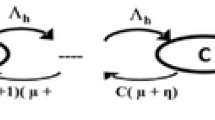Abstract
In mobile communication systems, a soft handoff (SHO) technique is used to optimize the quality and capacity of communications. However, because the handoff process incurs a high overhead there must be a tradeoff between the system capacity and the handoff overhead. In this paper, we propose a benefit optimization model for mobile communications. The model tries to maximize the overall system capacity by considering SHO process overhead and quality of service requirements jointly. We first construct a framework of admission policies and devise an appropriate admission control policy, which is then used to analyze the system benefit. The service rate is defined by three measures: the call blocking ratio, system load, and admit-to-existence ratio; while the solution quality is defined by the gap between the upper bound and lower bound of the objective function value. By applying iteration-based Lagrangian relaxation as a solution approach, a time budget is allocated to each iteration so that admission control can be implemented. To fulfill the continuous admission process requirements in the long-term, users’ demands are randomly distributed via a simulation process. The goal of this paper is to investigate the effect of the admission control policy on the system benefit, service rate and solution quality. Experiment results are presented to demonstrate the efficacy of both the proposed model and the solution approach.













Similar content being viewed by others
References
Takeo, K., Sato, S.: Evaluation of a CDMA cell design algorithm considering non-uniformity of traffic and base station locations. IEICE Trans. Fundam. Electron. Commun. Comput. Sci. E81-A(7), 1367–1377 (1998)
Hanly, S.V.: An algorithm for combined cell-site selection and power control to maximize cellular spread spectrum capacity. IEEE J. Sel. Areas Commun. 13(7), 1332–1340 (1995)
Chang, J.W., Chung, J.H., Sung, D.K.: Admission control scheme for soft handoff in DS-CDMA cellular systems supporting voice and stream-type data services. IEEE Trans. Veh. Technol. 51(6), 1445–1459 (2002)
Chu, K.-C., Hung, L.-P., Lin, F.Y.-S.: Adaptive channel reservation for call admission control to support prioritized soft handoff calls in a cellular CDMA system. Ann. Telecommun. (2009), (forthcoming). doi:10.1007/s12243-009-0126-x
Sang, A., Wang, X., Madihian, M., Gitlin, R.D.: Coordinated load balancing, handoff/cell-site selection, and scheduling in multi-cell packet data systems. Wirel. Netw. 14, 103–120, February (2008), doi:10.1007/s11276-006-8533-7
Houtao, Z., Buot, T., Nagaike, R., Harmen, S.: Load balancing in WCDMA systems by adjusting pilot power. Proc. IEEE WPMC 3, 936–940 (2002)
Akar, M.: Optimal power and handoff control for CDMA wireless networks. Proc. IEEE ICC 11, 4918–4923 (2006)
Sheu, S.-T., Wu, C.-C.: Using grey prediction theory to reduce handoff overhead in cellular communication systems. Proc. IEEE PIMRC 2, 782–786 (2000)
Chen, H., Wu, H., Kumar, S., Tzeng, N.-F.: Minimum-cost data delivery in heterogeneous wireless networks. IEEE Trans. Veh. Technol. 56(6), 3511–3523 (2007)
Alpcan, T., Basar, T.: A hybrid systems model for power control in multicell wireless data networks. Perform. Eval. 57(4), 477–495 (2004)
Chu, K.-C., Lin, F.Y.-S., Hung, L.-P.: The effect of call admission policies on the system benefit of CDMA communication networks. Telecommun Syst (2010) (forthcoming)
Han, J.: Frequency reassignment problem in mobile communication networks. Comput. Oper. Res. 34(10), 2939–2948 (2007)
Shen, J., Xu, F., Zheng, P.: A tabu search algorithm for the routing and capacity assignment problem in computer networks. Comput. Oper. Res. 32(11), 2785–2800 (2005)
Fischetti, M., Lepschy, C., Minerva, G., Romanin-Jacur, G., Toto, E.: Frequency assignment in mobile radio systems using branch-and-cut techniques. Eur. J. Oper. Res. 123(2), 241–255 (2000)
Castelino, D.J., Hurley, S., Stephens, N.M.: A tabu search algorithm for frequency assignment. Ann. Oper. Res. 63, 301–319 (1996)
Chu, K.-C., Lin, F.Y.-S.: Survivability and performance optimization of mobile wireless communication networks in the event of base station failure. Comput. Electr. Eng. 32(1–3), 50–64 (2006)
Shin, S.M., Cho, C.-H., Sung, D.K.: Interference-based channel assignment for DS-CDMA cellular systems. IEEE Trans. Veh. Technol. 48(1), 233–239 (1999)
Dahlhaus, D., Cheng, Z.: Smart antenna concepts with interference cancellation for joint demodulation in the WCDMA UTRA uplink. Proc. IEEE ISSSTA 1, 244–248 (2000)
Hernandez, M.A., Janssen, G.J.M., Prasad, R.: Uplink performance enhancement for WCDMA systems through adaptive antenna and multiuser detection. Proc. IEEE VTC-Spring 1, 571–575 (2000)
Fisher, M.L.: The Lagrangian relaxation method for solving integer programming problemss. Manag. Sci. 27, 1–18 (1981)
Held, M., Wolfe, P., Crowder, H.D.: Validation of subgradient optimization. Math. Program. 6, 62–88 (1974)
Um, H.-Y., Lim, S.-Y.: Call admission control schemes for DS-CDMA cellular system supporting an integrated voice/data traffic. Proc. IEEE ISCC 365–369 (1998)
Acknowledgments
This paper was funded by the National Science Council of Taiwan (NSC 95-2416-H-228-004). It also received the Dragon Thesis Award Gold Medal from the Acer Foundation in 2005.
Author information
Authors and Affiliations
Corresponding author
Appendix
Rights and permissions
About this article
Cite this article
Chu, KC., Wang, CS. & Lin, F.YS. An Admission Control-based Benefit Optimization Model for Mobile Communications: the Effect of a Decision Time Budget. J Netw Syst Manage 18, 169–189 (2010). https://doi.org/10.1007/s10922-009-9152-2
Published:
Issue Date:
DOI: https://doi.org/10.1007/s10922-009-9152-2






